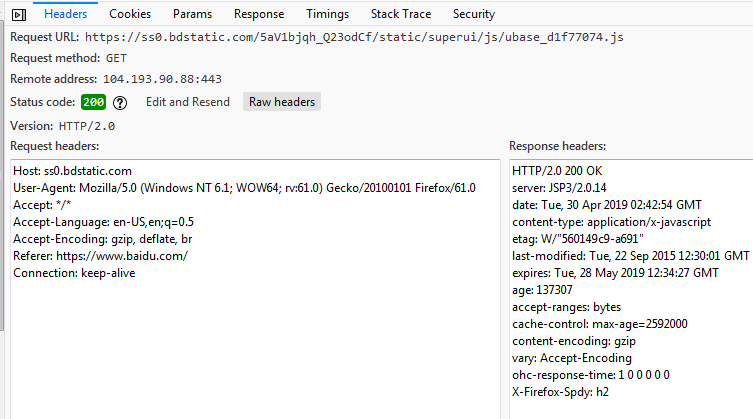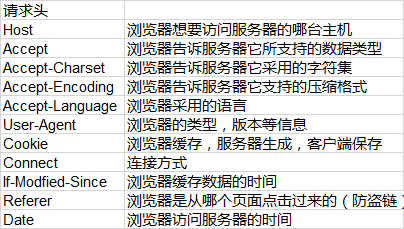HttpClient是模拟Http协议客户端请求的一种技术,可以发送Get/Post等请求。 所以在学习HttpClient测试框架之前,先来看一下Http协议请求,主要看请求头信息。
如何查看HTTP协议请求头信息: 打开浏览器-->输入任意一个网址-->按下F12 打开开发者工具-->Network-->刷新页面,可以在Network看到有Get或者post请求的URL,点击URL,可以看到该请求的Header/Cookies/Response等信息
例如我们打开www.baidu.com,查看它某个请求的信息,如下:

常用的请求头和响应头信息解释:


下面通过一个简单的例子学习HttpClient
import java.io.IOException; import java.util.List; import org.apache.http.HttpResponse; import org.apache.http.client.CookieStore; import org.apache.http.client.methods.HttpGet; import org.apache.http.cookie.Cookie; import org.apache.http.impl.client.DefaultHttpClient; import org.apache.http.util.EntityUtils; import org.testng.annotations.Test; public class MyHttpClient { @Test public void test1() { String result; HttpGet get = new HttpGet("http://localhost:8888/getCookies"); DefaultHttpClient client = new DefaultHttpClient(); try { HttpResponse response = client.execute(get); result = EntityUtils.toString(response.getEntity()); CookieStore cookieStore = client.getCookieStore(); List<Cookie> cookies =cookieStore.getCookies(); System.out.println(cookies.size()); for(Cookie c :cookies) {//get Cookies info System.out.println(c.getName() + ":" + c.getValue()); } } catch (IOException e) { e.printStackTrace(); } } }
Run TestNG Test, 可以看到返回的result是HTML源码。这个是通过HttpClient Get请求方法实现的简单例子。下面结合Mock模拟数据,学习如何使用HttpClient。
Mock一个返回Cookies信息的请求:
{
"description":"This get request with cookies return",
"request":{
"uri":"/getCookies",
"method":"get"
},
"response":{
"cookies":{
"login":"true"
},
"text":"This is response with cookies"
}
}
具体如何Mock数据可以参考上一篇文章《Mock接口平台Moco学习》.
我们已经知道如何从服务端获取 Cookie信息了,那下一步学习客户端如何使用拿到的Cookie信息。
首先在Mock一个接口,这是携带/getCookies 接口返回的Cookies信息Get请求的接口:
{
"description":"This is Get request with cookies",
"request":{
"uri":"/get/with/cookies",
"method":"get",
"cookies":{
"login":"true"
}
},
"response":{
"text":"This is response for get request with cookies"
}
}
完整的代码:
import java.io.IOException; import java.util.List; import org.apache.http.HttpResponse; import org.apache.http.client.CookieStore; import org.apache.http.client.methods.HttpGet; import org.apache.http.cookie.Cookie; import org.apache.http.impl.client.DefaultHttpClient; import org.apache.http.util.EntityUtils; import org.testng.annotations.Test; public class MyHttpClient { private CookieStore cookieStore; @Test public void test1() { String result; HttpGet get = new HttpGet("http://localhost:8888/getCookies"); DefaultHttpClient client = new DefaultHttpClient(); try { HttpResponse response = client.execute(get); result = EntityUtils.toString(response.getEntity()); System.out.println("result=" + result); cookieStore = client.getCookieStore(); List<Cookie> cookies = cookieStore.getCookies(); System.out.println(cookies.size()); for (Cookie c : cookies) { System.out.println(c.getName() + ":" + c.getValue()); } } catch (IOException e) { e.printStackTrace(); } } @Test(dependsOnMethods = { "test1" }) public void testGetWithCookie() { HttpGet get = new HttpGet("http://localhost:8888/get/with/cookies"); DefaultHttpClient client = new DefaultHttpClient(); // Set cookie info client.setCookieStore(cookieStore); try { HttpResponse response = client.execute(get); // get response status int statusCode = response.getStatusLine().getStatusCode(); // statusCode = 200 / 404 / 502..... System.out.println("Status = " + statusCode); if (statusCode == 200) { // Success String result = EntityUtils.toString(response.getEntity()); System.out.println("result=" + result); } } catch (IOException e) { // TODO Auto-generated catch block e.printStackTrace(); } } }
HttpClient Post请求的实现:
首先还是Mock一个post请求
{
"description":"This is Post request with cookies",
"request":{
"uri":"/post/with/cookies",
"method":"post",
"cookies":{
"login":"true"
},
"json":{
"name":"zhangsan",
"age":"18"
}
},
"response":{
"status":200,
"json":{
"zhangsan":"success",
"status":"1"
}
}
}
完整的Post请求代码:
import java.io.IOException; import java.util.List; import org.apache.http.HttpResponse; import org.apache.http.client.CookieStore; import org.apache.http.client.methods.HttpGet; import org.apache.http.client.methods.HttpPost; import org.apache.http.cookie.Cookie; import org.apache.http.entity.StringEntity; import org.apache.http.impl.client.DefaultHttpClient; import org.apache.http.util.EntityUtils; import org.json.JSONObject; import org.testng.Assert; import org.testng.annotations.Test; public class MyCookiesForPost { private CookieStore cookieStore; @Test public void test1() { String result; HttpGet get = new HttpGet("http://localhost:8888/getCookies"); DefaultHttpClient client = new DefaultHttpClient(); try { HttpResponse response = client.execute(get); result = EntityUtils.toString(response.getEntity()); System.out.println("result=" + result); cookieStore = client.getCookieStore(); List<Cookie> cookies = cookieStore.getCookies(); System.out.println(cookies.size()); for (Cookie c : cookies) { System.out.println(c.getName() + ":" + c.getValue()); } } catch (IOException e) { e.printStackTrace(); } } @Test(dependsOnMethods = { "test1" }) public void testPostWithCookie() { //1. Define a client to excute //2. Define a post method //3. Add pamarater //4. Set request header info; set cookie inof //5. Execute //6. Get and handle Result //7. assert result DefaultHttpClient client = new DefaultHttpClient(); HttpPost post = new HttpPost("http://localhost:8888/post/with/cookies"); JSONObject param = new JSONObject(); param.put("name", "zhangsan"); param.put("age", "18"); StringEntity entity = new StringEntity(param.toString(),"utf-8"); post.setEntity(entity); post.addHeader("content-type", "application/json"); client.setCookieStore(cookieStore); try { HttpResponse response = client.execute(post); String result = EntityUtils.toString(response.getEntity()); System.out.println("result=" + result); JSONObject object = new JSONObject(result); System.out.println("zhangsan=" + object.getString("zhangsan")); System.out.println("status=" + object.getString("status")); String actualResult = object.getString("zhangsan"); Assert.assertEquals(actualResult,"success"); } catch (IOException e) { // TODO Auto-generated catch block e.printStackTrace(); } } }
代码优化: 在实际的测试过程当中,我们一般不会直接将请求地址写在请求对象当中。而是定义在配置文件中,然后在代码中引用。具体用法如下。
创建一个.properties文件,如config.properties:
test.url=http://localhost:8888
然后在代码中读取该config.properties,并获取相应的地址:
private ResourceBundle bundle; private String url; @BeforeTest public void beforeTest() { bundle = ResourceBundle.getBundle("config"); url = bundle.getString("test.url"); }
以上是HttpClient的常见用法和其中一个优化方案。
如果喜欢作者的文章,请关注"写代码的猿"订阅号以便第一时间获得最新内容。本文版权归作者所有,欢迎转载.

我的博客即将同步至腾讯云+社区,邀请大家一同入驻:https://cloud.tencent.com/developer/support-plan?invite_code=2wrsyxyyavcwc